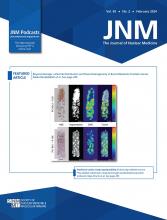REPLY: We have reviewed the letter to the editor entitled, “Unraveling the Hypocalcemic Response to 177Lu-Prostate-Specific Membrane Antigen Therapy,” which refers to our published article, “The Tyr Phenomenon: A Hypocalcemic Response in High-Volume Treatment Responders to 177Lu-Prostate-Specific-Membrane Antigen Therapy” (1). We thank the authors for their interest in our article.
We describe a novel phenomenon of severe hypocalcemia in patients with high-volume bone metastatic prostate cancer who respond to 177Lu-prostate-specific membrane antigen (PSMA) treatment. Patients who developed hypocalcemia (<2.10 mmol/L) during 177Lu-PSMA had significantly higher markers of pretreatment disease burden, including baseline SPECT total tumor volume (median, 3,249 cm3 [interquartile range (IQR), 1,856–3,852 cm3] vs. 465 cm3 [IQR, 135–1,172 cm3]; P = 0.002), baseline prostate-specific antigen concentration (median, 471 ng/mL [IQR, 108–1,380 ng/mL] vs. 76 ng/mL [IQR, 22–227 ng/mL]; P = 0.008), and baseline alkaline phosphatase concentration (median, 311 U/L [IQR, 195–2,046] vs. 114 U/L [IQR, 69–184 U/L]; P < 0.001). Patients who developed hypocalcemia also demonstrated a greater prostate-specific antigen response between the first- and third-dose 177Lu-PSMA (median, 85% [IQR, 53%–91%] vs. 47% [IQR, 1%–77%]; P = 0.022).
We suspect that an exaggerated osteoblastic response drove the hypocalcemia in our 2 most severe cases given the markedly elevated alkaline phosphatase and procollagen type 1 N-propeptide concentrations at hypocalcemia onset and the rapid response of serum calcium and bone formation markers to high-dose prednisone therapy, which is known to suppress osteoblastogenesis and promote osteoblast apoptosis (2,3). It is unclear whether this osteoblastic response is specifically occurring in the osteoblastic bone metastases or is a more generalized skeletal response. Interrogation of further cases with transiliac bone biopsy, including histomorphometric indices of bone turnover and micro-CT assessment of trabecular and cortical bone morphology, will likely provide important insights. We agree that our cases differ from those with hypocalcemia in the setting of progressive bone metastases (4), as the hypocalcemia occurred in association with excellent responses to treatment.
The authors postulate whether parathyroid hormone–related protein suppression in the tumor microenvironment and subsequent reduction in osteoclastic activity may have been the driving factor for hypocalcemia. This is a reasonable hypothesis, which we did not examine. However, given the evidence for an exaggerated osteoblastic response, we suspect parathyroid hormone–related protein suppression was not a major underlying factor for the hypocalcemia, particularly given that the 2 more severe cases had recent high-dose denosumab, which is already a potent suppressant of osteoclast activity (5). Indeed, one of our patients had a low-normal serum C-terminal telopeptide of type 1 collagen at the onset of hypocalcemia (113 μg/L; normal range, 100–750 µg/L). Further, we were unable to identify any cases in the literature describing hypocalcemia secondary to parathyroid hormone–related protein suppression. Most patients in our cohort had underlying bone metastases (>95%), and we demonstrated that onset of hypocalcemia during 177Lu-PSMA treatment correlated with greater prostate-specific antigen response.
Patients who developed hypocalcemia in our cohort had a significantly lower hemoglobin nadir between the first and third doses of 177Lu-PSMA (median, 95 g/L [IQR, 76–114 g/L] vs. 112 g/L [IQR, 102–122 g/L]; P = 0.029). There is concern that an osteoblastic hypersclerotic reaction may compromise marrow reserve; however, various factors can contribute to anemia in such patients. Further, whereas our data suggest a short-term decline in hemoglobin, a long-term persistent hemoglobin reduction is more clinically relevant and would require a longer follow-up period.
We commenced high-dose prednisone in the 2 most severe cases of hypocalcemia to suppress the exaggerated osteoblastic response. 223Ra is a calcium mimetic that facilitates α-radiation preferentially to osteoblastic bone metastases exhibiting high bone turnover (6). However, as mentioned, the hypocalcemic phenotype we describe occurred in excellent treatment responders, and hence, administering alternative treatment with 223Ra at the onset of hypocalcemia would not have been considered suitable.
Shejil Kumar, Megan Crumbaker, Louise Emmett*
*St. Vincent’s Hospital Sydney, New South Wales, Australia
E-mail: louise.emmett{at}svha.org.au
- © 2024 by the Society of Nuclear Medicine and Molecular Imaging.
REFERENCES
- Revision received November 13, 2023.
- Accepted for publication November 14, 2023.







